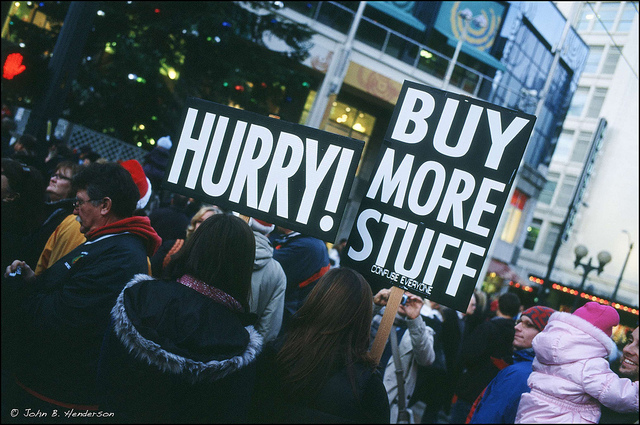Oh, Black Friday. It’s the nucleus of consumer season (or for that matter the entire consumer retail year), and therefore obviously a strong representation of everything that Postconsumers is working to raise awareness about and combat so that more people can find the satisfaction of enough. And while the engine that drives the momentum of Black Friday is a societal case of addictive consumerism, the gas that fuels it is the mass media and the huge budgets spent on Black Friday advertising. Today, we thought we’d take a look at exactly how much money is wrapped up in simply the advertising portion of Black Friday.
Why Do Companies Spend So Much Money on Black Friday Advertising?
If you’re wondering why companies spend so much money on advertising for Black Friday, Cyber Monday and the time surrounding both, it’s because their annual sales and revenue projections require it. According to the National Retail Institute, the percentage of an industry’s revenue for the entire year can range from between a low of 13.4% (electronics stores – surprisingly) to a high of 23.8% (jewelry stores) in December, with a similar number in November during the holiday build up. That means that in some industries you can expect between 35-50% of the entire annual sales cycle to happen in the month leading up to and following Black Friday. So you can see why retailers think that it’s so important to have their name and their promotions out there leading up to the “big day.”
So, Exactly How Much Money Got Spent on Advertising?
According to Kantar Media, the most recent numbers (for the year 2013) show a quarter of a billion dollars was spent on television advertising by the top retailers in the weeks leading up to Thanksgiving. So, to be clear, that number doesn’t even represent the total amount of advertising dollars spent on Black Friday advertising since we’re all painfully aware that Black Friday advertising begins as early as Halloween these days. And it also only represents television advertising. We’re all aware that as television advertising decreases in value, there’s a growing chunk of advertising revenue that’s being spent on streaming advertisements, online advertisements and even print advertisements (they’re making a comeback!). We’re not experts, but we suspect when you add everything up, you may well be looking in the range of a billion dollars. Of course, it could easily be more. That’s a huge amount of money spent to propagate the idea of rushing out of the house on Thanksgiving weekend to spend even more money on stuff, stuff and more stuff.
So Who Spent the Most?
It probably won’t surprise you that the originator of the “door buster” concept spent the most on television advertising in the week leading up to Thanksgiving. Walmart spent $57 million on television advertising between November third and fifteenth. Target spent $28 million. Sears spent $26 million and Macy’s spent $25 million. Home improvement stores also spent giant chunks on television advertising. Home Depot spent just a million dollars less than Lowe’s, coming in at $16 million. And though electronics stores seem to rely less on the holiday season, it’s still a major portion of their revenue and their advertising spends reflect that. Best Buy poured a cool $25 million into pre-Black Friday advertising.
What About Other Forms of Advertising?
This web number is more interesting given the shift of consumers to purchase online rather than subject themselves to the unpleasantness of Black Friday in stores. Unfortunately, the number is nearly impossible to come by. What we were able to find, thanks to Statistics Brain, is a list of the top ten companies who bid the most on the Google keyword “Black Friday.” What we can assure you even without knowing the number spent is that the keyword “Black Friday” is not cheap and is searched millions and millions of times in the weeks leading up to it. The companies who spent the most bidding on it were:
- Best Buy
- Kohl’s
- Radio Shack
- Macy’s
- JC Penny
- Sears
- K-Mart
- Express
- Nike
- Overstock.com
So, did all of that advertising revenue make a difference? The answer is both yes and no. Though pure retail numbers for Black Friday sales have been down for several years, holiday spending overall has remained steady. So if the goal of the advertising dollars is to keep people invested in Black Friday shopping as a concept, then we “congratulate” them, well-played advertisers.
Did we miss a fact about Black Friday advertising spending that you want to share with us? If so, just tell us about it on one of the social media channels below.
Facebook | Twitter | Instagram | Tumblr | Pinterest | Google+ | Medium
Photo Credit: John Henderson via Flickr





